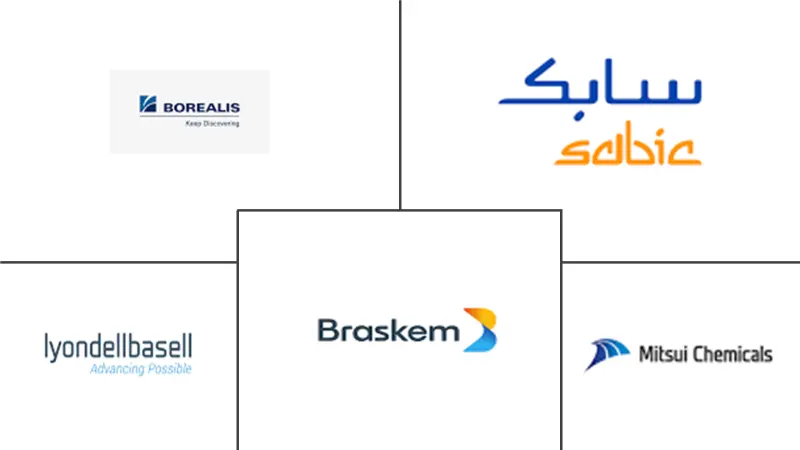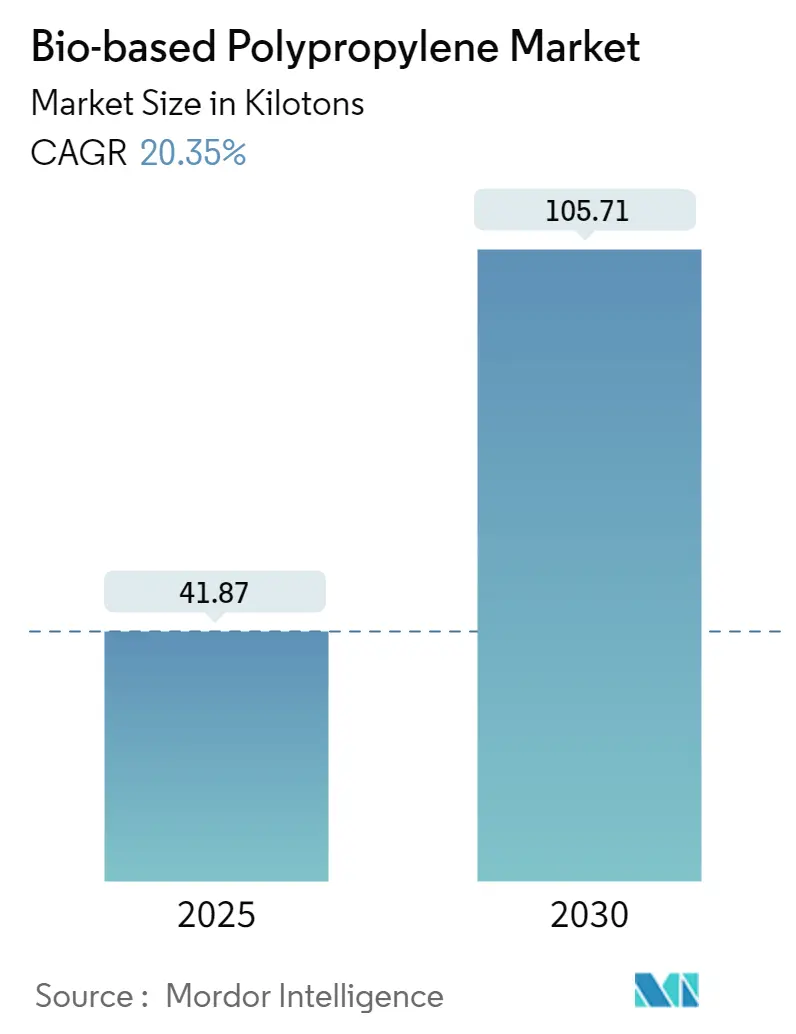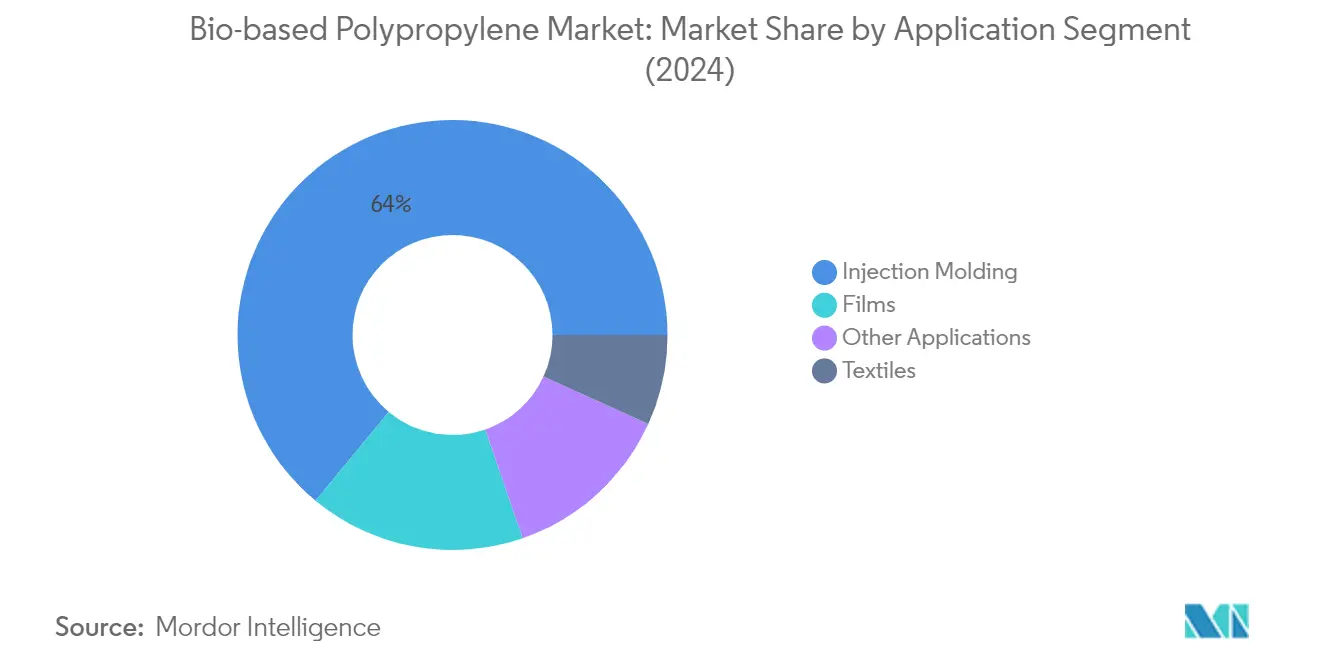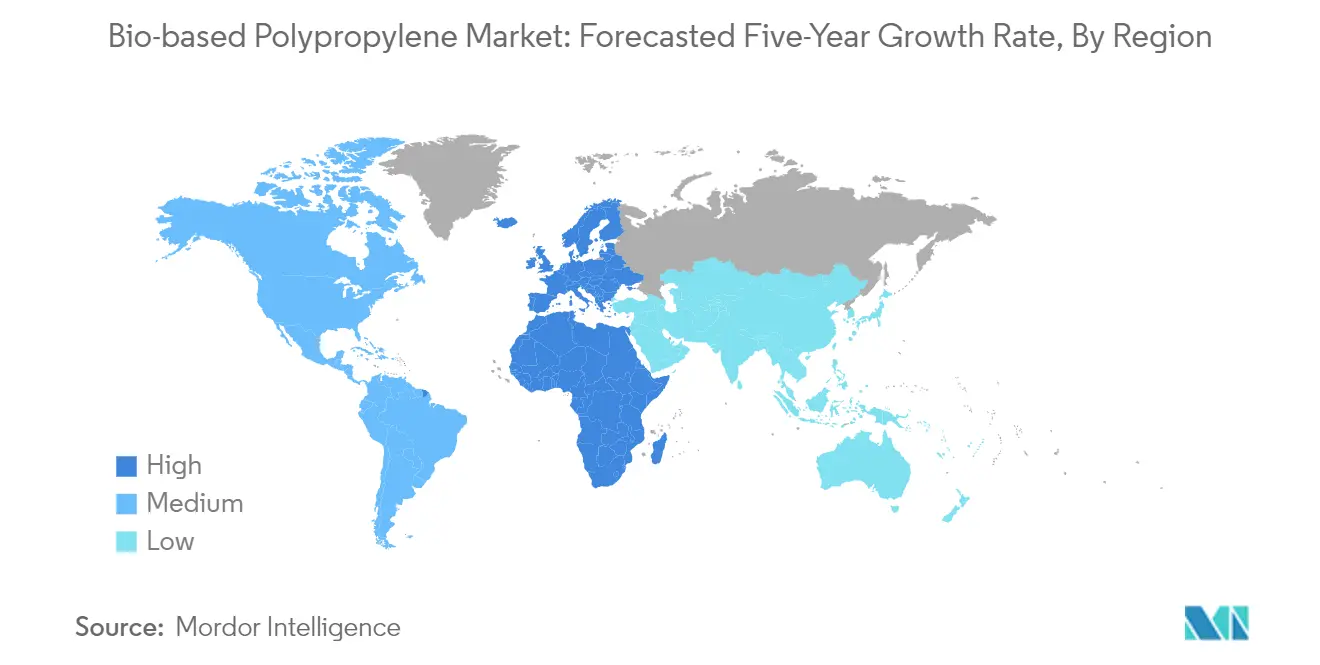Bio-based Polypropylene Market Analysis
The Bio-based Polypropylene Market size is estimated at 41.87 kilotons in 2025, and is expected to reach 105.71 kilotons by 2030, at a CAGR of 20.35% during the forecast period (2025-2030).
The bio-based polypropylene industry is experiencing significant transformation driven by technological advancements in production processes and expanding application scope. Major industry players are actively pursuing innovative production methods, with companies like Mitsui Chemicals pioneering the first-of-its-kind IPA method that produces bio polypropylene through the fermentation of non-edible plants. This technological progress has enabled manufacturers to achieve higher production efficiencies and better product quality, making bio-based polypropylene alternatives increasingly competitive with traditional petroleum-based polypropylene.
The market landscape is being reshaped by strategic partnerships and collaborations aimed at accelerating commercialization and market penetration. In June 2021, several significant partnerships were formed, including SABIC's collaboration with Delica AG for sustainable coffee capsules, and the partnership between Neste, Mitsui Chemicals, and Toyota Tsusho to launch Japan's first production of renewable plastics from 100% bio-based polypropylene hydrocarbon. These collaborations demonstrate the industry's commitment to scaling up production and expanding into new application areas.
Consumer electronics and automotive sectors are emerging as key growth drivers for bio-based polypropylene applications. The Canadian consumer electronics industry, for instance, is projected to reach USD 7,349 million by 2025, representing significant potential for bio-based polypropylene materials in electronic components and packaging. The automotive sector's increasing focus on lightweight, sustainable materials has created new opportunities for bio-based polypropylene in vehicle components and interior applications.
Regulatory support and standardization efforts are playing crucial roles in market development. The European Union's revised waste package encourages member states to support bio-based polypropylene materials in packaging applications, while implementing mandatory separate collection of bio-waste across Europe. This regulatory framework, combined with certification systems like the International Sustainability and Carbon Certification (ISCC), is creating a more structured and reliable market environment for bio-based polypropylene products, particularly in developed regions.
Bio-based Polypropylene Market Trends
Rising Environmental Concerns Regarding the Usage of Conventional Plastics
The escalating environmental impact of conventional plastics has become a critical global concern, with approximately 8 million tons of plastic waste being dumped into the oceans annually. This massive plastic pollution has led to severe degradation of marine habitats, affecting more than 200 species of marine organisms, including turtles, invertebrates, seabirds, fish, and mammals. These organisms face reduced movement, feeding difficulties, decreased reproductive output, and often suffer from ulcers and lacerations due to plastic entanglement or ingestion of microplastic molecules, frequently resulting in death. The persistence of plastic pollution in marine environments is particularly concerning due to the prolonged bio-physical degradation process of conventional plastics.
The environmental impact extends beyond marine ecosystems to terrestrial environments, where chlorinated plastics leach harmful chemicals into soil and groundwater systems. Studies have revealed that microplastics and synthetic polymer fibers remain detectable in soil even five years after their initial application to sewage sludge and agricultural lands. The decomposition of landfilled plastics releases methane and carbon dioxide, contributing significantly to greenhouse gas emissions and global warming. Additionally, the open burning of plastic waste releases dangerous pollutants, including heavy metals, dioxins, PCBs, and furans, which pose serious risks to air quality and human respiratory health. These comprehensive environmental concerns have driven the increasing adoption of bio-based alternatives like bio-based polypropylene, which offers a more sustainable solution to conventional plastic usage.
Increasing Replacement of Fossil-Based Feedstock with Renewable Materials
The transition from fossil-based feedstock to renewable materials represents a fundamental shift in industrial production, driven by both environmental sustainability and economic considerations. Recent consumer studies indicate that sustainability has become a crucial purchase criterion for 60% of consumers globally, with the United States showing an even higher preference at 61%. This growing consumer awareness has catalyzed the expansion of bio-based material production, evidenced by a significant 16% increase in global production capacities of bioplastics in 2023, reaching 2.4 million metric tons, with biodegradable bioplastics accounting for 1.6 million metric tons of the total capacity.
The replacement of fossil-based feedstock with renewable materials offers multiple advantages beyond environmental benefits. Bio-based products demonstrate the potential for being more eco-friendly through less polluting production processes compared to petrochemical alternatives. These materials contribute to climate change mitigation as they are considered climate-neutral, absorbing CO2 during growth and releasing it during use or waste phases. Furthermore, the transition to renewable materials supports rural development through the creation of regional processing facilities dependent on locally grown bio-based crops. This shift also helps diversify feedstock sources, reducing dependence on imported oil and strengthening industrial base sustainability. The growing adoption of renewable materials is further supported by government initiatives worldwide, with many countries actively investing in bio-based industries to ensure long-term economic and environmental sustainability.
The bio-based polypropylene market is a key area of growth, with bio pp and bio polypropylene being increasingly used as alternatives to traditional plastics, enhancing both environmental and economic outcomes.
Segment Analysis: APPLICATION
Injection Molding Segment in Bio-based Polypropylene Market
The injection molding segment dominates the bio-based polypropylene market, commanding approximately 64% of the total market share in 2024. This significant market position is driven by the segment's extensive applications across various industries, including automotive, medical devices, and consumer goods manufacturing. The growing adoption of bio-based polypropylene in injection molding applications is primarily attributed to its superior properties that match conventional polypropylene, making it an ideal drop-in solution for existing manufacturing processes. The automotive industry, in particular, has shown an increased preference for injection-molded bio-based polypropylene components due to their contribution to vehicle weight reduction and environmental sustainability goals. Additionally, the medical device industry's growing demand for sustainable materials in manufacturing various equipment and components has further strengthened this segment's market leadership.
Injection Molding Segment in Bio-based Polypropylene Market - Growth Analysis
The injection molding segment is projected to maintain its position as the fastest-growing segment in the bio-based polypropylene market during 2024-2029, with an expected growth rate of approximately 23%. This remarkable growth trajectory is fueled by increasing environmental regulations promoting the use of sustainable materials in manufacturing processes, particularly in developed regions. The segment's growth is further supported by technological advancements in injection molding processes that have improved the processing capabilities of bio-based polypropylene, making it more compatible with existing manufacturing equipment. The rising demand for sustainable packaging solutions and the automotive industry's shift towards lightweight, eco-friendly components are also significant factors driving this segment's rapid expansion.
Remaining Segments in Bio-based Polypropylene Market
The films and textiles segments, along with other applications, constitute important segments in the bio-based polypropylene market. The films segment has gained significant traction in packaging applications, particularly in food packaging and agricultural films, driven by increasing consumer awareness about sustainable packaging solutions. The textiles segment has found applications in sustainable fabric production, particularly in the manufacturing of eco-friendly apparel and industrial textiles. Other applications include blow molding and thermoforming, which are increasingly being adopted in various industries for producing sustainable containers, bottles, and other molded products. These segments collectively contribute to the market's diversification and demonstrate the versatility of bio-based polypropylene across different industrial applications.
Bio-based Polypropylene Market Geography Segment Analysis
Bio-based Polypropylene Market in Asia-Pacific
The Asia-Pacific region represents a significant bio-based polypropylene market, driven by increasing environmental regulations and growing awareness about sustainable materials. Countries like Japan, China, South Korea, and India are making substantial investments in bio polypropylene technologies and manufacturing capabilities. The region's strong manufacturing base, particularly in the automotive and electronics sectors, provides numerous opportunities for bio-based polypropylene applications. Government initiatives promoting the use of renewable materials and reducing dependency on fossil-based feedstock have created a favorable environment for market growth.
Bio-based Polypropylene Market in Japan
Japan leads the Asia-Pacific market with approximately 92% market share in the region. The country's advanced technological capabilities and strong focus on sustainable development have positioned it as a pioneer in bio-based polypropylene materials. Japanese companies are actively collaborating with international partners to develop innovative bio-based polypropylene solutions. The country's robust automotive and electronics manufacturing sectors are major consumers of bio-based polypropylene, particularly in injection molding applications. The government's support through various environmental policies and regulations has further strengthened Japan's position in the bio-based polypropylene market.
Bio-based Polypropylene Market Growth in Japan
Japan is also the fastest-growing market in the Asia-Pacific region, with an expected growth rate of approximately 18% during 2024-2029. The country's commitment to reducing carbon emissions and promoting circular economy principles is driving this growth. Japanese manufacturers are increasingly adopting bio pp materials in their production processes, particularly in packaging and automotive applications. The country's strong research and development infrastructure continues to drive innovation in bio-based technologies. This growth is further supported by increasing consumer awareness and preference for sustainable products.
Bio-based Polypropylene Market in North America
North America represents a mature market for bio-based polypropylene, characterized by strong technological capabilities and increasing environmental consciousness. The region's market is primarily driven by the United States, Canada, and Mexico, with significant investments in bio-based material research and development. The presence of major industry players and strong regulatory support for sustainable materials has created a robust ecosystem for bio-based polypropylene growth. The region's automotive, packaging, and consumer goods industries are major consumers of bio-based polypropylene, driving market expansion.
Bio-based Polypropylene Market in United States
The United States dominates the North American market with approximately 94% market share. The country's strong manufacturing base and technological advancement have made it a leader in bio-based materials adoption. American companies are at the forefront of developing innovative applications for bio-based polypropylene, particularly in the automotive and packaging sectors. The presence of major research institutions and strong industry-academia collaboration has fostered continuous innovation in bio-based technologies. The country's robust infrastructure and established distribution networks further support market growth.
Bio-based Polypropylene Market Growth in United States
The United States leads the growth trajectory in North America with an expected growth rate of approximately 20% during 2024-2029. This growth is driven by increasing adoption of sustainable materials across various industries and strong government support for bio-based materials. The country's focus on reducing carbon emissions and promoting a circular economy has created numerous opportunities for bio-based polypropylene applications. American manufacturers are increasingly incorporating bio pp materials in their production processes, particularly in high-performance applications. The growing consumer awareness about environmental sustainability continues to drive market expansion.
Bio-based Polypropylene Market in Europe
Europe stands at the forefront of bio-based polypropylene adoption, with countries like Germany, the United Kingdom, France, and Italy leading the way. The region's strong environmental regulations and commitment to sustainability have created a favorable environment for market growth. European manufacturers are actively investing in bio-based technologies and sustainable production methods. The region's automotive, packaging, and consumer goods industries are major consumers of bio-based polypropylene, driving market expansion through innovative applications.
Bio-based Polypropylene Market in Germany
Germany leads the European market in bio-based polypropylene consumption. The country's strong manufacturing base, particularly in the automotive and industrial sectors, drives the demand for bio-based materials. German companies are known for their technological innovation and commitment to sustainability, making them key players in the bio-based polypropylene market. The country's robust research and development infrastructure continues to drive innovation in bio-based technologies. Government support through various environmental policies and regulations has further strengthened Germany's position in the market.
Bio-based Polypropylene Market Growth in Germany
Germany demonstrates the fastest growth rate in the European region. The country's strong focus on the circular economy and sustainable development drives this growth. German manufacturers are increasingly adopting bio-based materials in their production processes, particularly in high-performance applications. The country's automotive industry leads in incorporating bio-based polypropylene in various components. Strong research and development capabilities, coupled with government support, continue to drive innovation in bio-based technologies.
Bio-based Polypropylene Market in Rest of the World
The Rest of the World region, encompassing the Middle East and Africa, shows growing potential in the bio-based polypropylene market. These regions are witnessing increasing awareness about sustainable materials and growing environmental concerns. Government initiatives to reduce dependency on conventional plastics and promote biodegradable alternatives are driving market growth. The packaging and agricultural sectors are major consumers of bio-based polypropylene in these regions. While the market is still developing, increasing investments in bio-based technologies and growing environmental consciousness are expected to drive future growth.
Bio-based Polypropylene Industry Overview
Top Companies in Bio-based Polypropylene Market
The bio-based polypropylene market is characterized by significant product innovation and strategic partnerships across the value chain. Companies are heavily investing in research and development to develop more cost-effective production methods and expand their renewable feedstock sources. Strategic collaborations between raw material suppliers, technology providers, and bio polypropylene manufacturers have become increasingly common to ensure stable supply chains and market expansion. Major players are focusing on vertical integration and establishing partnerships with downstream companies in various end-user industries, particularly the automotive, packaging, and consumer goods sectors. The industry has also witnessed a strong emphasis on obtaining sustainability certifications and developing proprietary technologies for bio-based production processes, demonstrating the sector's commitment to environmental stewardship and product quality.
Consolidated Market with Strong Growth Potential
The bio-based polypropylene market exhibits a highly consolidated structure with a small number of global chemical conglomerates dominating the landscape. These major players leverage their extensive manufacturing capabilities, established distribution networks, and strong research and development infrastructure to maintain their market positions. The market is primarily led by companies with a significant presence in conventional petrochemical industries that are strategically diversifying into bio-based alternatives. Regional players and specialized bio-polymer companies are gradually emerging, particularly in Europe and Asia-Pacific, though their market share remains relatively limited.
The industry has witnessed several strategic partnerships and joint ventures rather than outright acquisitions, as companies prefer to share technological expertise and market risks. Major chemical companies are increasingly partnering with renewable feedstock suppliers and end-user industries to develop integrated value chains. These collaborations often involve joint product development, testing, and commercialization efforts, particularly in high-value applications such as automotive components and packaging materials. The market structure encourages long-term supply agreements and strategic alliances rather than aggressive acquisition strategies.
Innovation and Sustainability Drive Future Success
Success in the bio-based polypropylene market increasingly depends on technological innovation and sustainable production capabilities. Companies must focus on developing cost-effective production processes while maintaining product quality comparable to conventional polypropylene. The ability to secure reliable sources of renewable feedstock through strategic partnerships with agricultural and waste management sectors is becoming crucial. Market leaders are investing in circular economy initiatives and developing comprehensive sustainability programs to address growing environmental concerns and regulatory requirements. Building strong relationships with end-users and understanding their specific requirements for bio pp materials is essential for long-term success.
For new entrants and smaller players, specialization in specific applications or regional markets offers opportunities for growth. Success factors include developing proprietary technologies, establishing niche market positions, and forming strategic alliances with established players. The market faces moderate substitution risk from other bio-based polymers, making product differentiation and performance crucial. Regulatory support for bio-based materials varies significantly across regions, creating both opportunities and challenges for market participants. Companies must also address end-user concerns about price stability and supply reliability while maintaining competitive pricing against conventional polypropylene manufacturers.
Bio-based Polypropylene Market Leaders
-
Borealis AG
-
Braskem
-
Mitsui Chemicals, Inc.
-
SABIC
-
LyondellBasell Industries Holdings BV
- *Disclaimer: Major Players sorted in no particular order
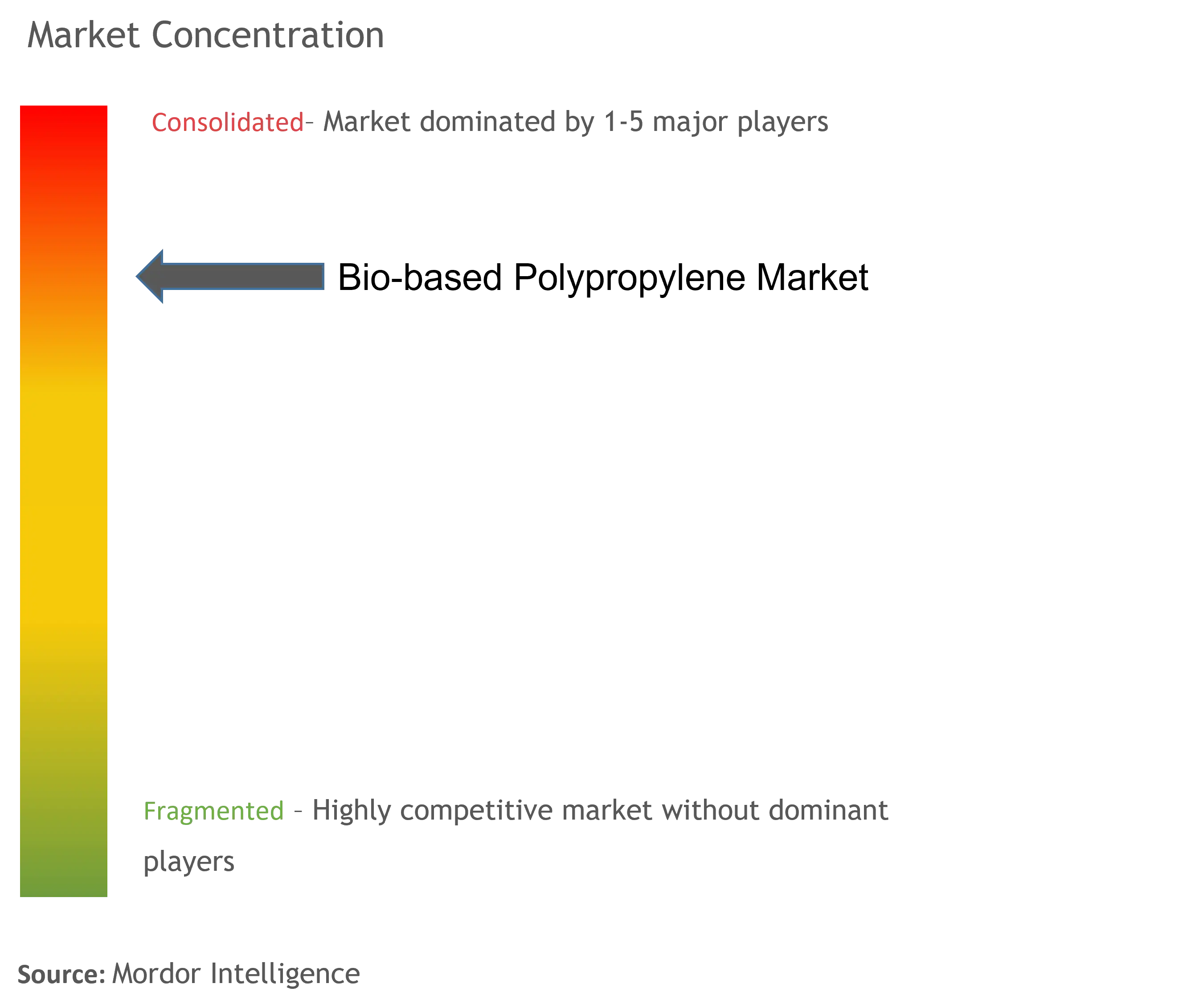
Bio-based Polypropylene Market News
- January 2023: Braskem announced a project to evaluate an investment in producing carbon-negative bio-based polypropylene (PP) in the United States. The project would utilize Braskem's proven and proprietary technology to convert bioethanol into physically segregated bio-based polypropylene.
- June 2022: Borealis partnered with PACCOR on mono-material polypropylene (PP) lids and tubs manufactured with ISCC PLUS certified renewable feedstock using a mass balance approach for the Froneri ice cream brand, Aino.
- March 2022: Mitsui Chemicals Inc. announced that its subsidiary Prime Polymer Co., Ltd. had become the first company in Japan to produce commercially and ship biomass polypropylene (PP).
Bio-based Polypropylene Market Report - Table of Contents
1. INTRODUCTION
- 1.1 Study Assumptions
- 1.2 Scope of the Study
2. RESEARCH METHODOLOGY
3. EXECUTIVE SUMMARY
4. MARKET DYNAMICS
-
4.1 Drivers
- 4.1.1 Rising Environmental Concerns Regarding the Usage of Conventional Plastics
- 4.1.2 Increasing Replacement of Fossil-based Feedstock with Renewable Materials
-
4.2 Restraints
- 4.2.1 High Cost of Bio-based Materials
- 4.2.2 Other Restraints
- 4.3 Industry Value Chain Analysis
-
4.4 Porter's Five Forces Analysis
- 4.4.1 Bargaining Power of Suppliers
- 4.4.2 Bargaining Power of Consumers
- 4.4.3 Threat of New Entrants
- 4.4.4 Threat of Substitute Products and Services
- 4.4.5 Degree of Competition
5. MARKET SEGMENTATION (Market Size in Volume)
-
5.1 Application
- 5.1.1 Injection Molding
- 5.1.2 Textiles
- 5.1.3 Films
- 5.1.4 Other Applications
-
5.2 Geography
- 5.2.1 Asia-Pacific
- 5.2.1.1 China
- 5.2.1.2 India
- 5.2.1.3 Japan
- 5.2.1.4 South Korea
- 5.2.1.5 Rest of Asia-Pacific
- 5.2.2 North America
- 5.2.2.1 United States
- 5.2.2.2 Canada
- 5.2.2.3 Mexico
- 5.2.3 Europe
- 5.2.3.1 Germany
- 5.2.3.2 United Kingdom
- 5.2.3.3 France
- 5.2.3.4 Italy
- 5.2.3.5 Rest of Europe
- 5.2.4 Rest of the World
6. COMPETITIVE LANDSCAPE
- 6.1 Mergers and Acquisitions, Joint Ventures, Collaborations, and Agreements
- 6.2 Market Share(%)**/Ranking Analysis
- 6.3 Strategies Adopted by Leading Players
-
6.4 Company Profiles
- 6.4.1 Biobent Management Services Inc.
- 6.4.2 Borealis AG
- 6.4.3 Borouge
- 6.4.4 Braskem
- 6.4.5 FKuR
- 6.4.6 INEOS
- 6.4.7 INTER Ikea SYSTEMS BV
- 6.4.8 LyondellBasell Industries Holdings BV
- 6.4.9 Mitsui Chemicals Inc.
- 6.4.10 SABIC
- *List Not Exhaustive
7. MARKET OPPORTUNITIES AND FUTURE TRENDS
- 7.1 Increasing Incentives by the Government Promoting the Usage of Bio-based Materials
- 7.2 Other Opportunities
Bio-based Polypropylene Industry Segmentation
Bio-based polypropylene is a polymer created using natural resources such as sugarcane, maize, vegetable oil, and other biomass. These polymers are progressively replacing traditional plastics. The bio-based polypropylene market report is segmented by application and geography. The market is segmented into injection molding, textiles, films, and other applications based on application. The report also covers the market size and forecast in 11 countries across major regions. The report offers market size and forecast for bio-based polypropylene in terms of volume (Kilotons) for all the above segments.
| Application | Injection Molding | ||
| Textiles | |||
| Films | |||
| Other Applications | |||
| Geography | Asia-Pacific | China | |
| India | |||
| Japan | |||
| South Korea | |||
| Rest of Asia-Pacific | |||
| North America | United States | ||
| Canada | |||
| Mexico | |||
| Europe | Germany | ||
| United Kingdom | |||
| France | |||
| Italy | |||
| Rest of Europe | |||
| Rest of the World | |||
Bio-based Polypropylene Market Research FAQs
How big is the Bio-based Polypropylene Market?
The Bio-based Polypropylene Market size is expected to reach 41.87 kilotons in 2025 and grow at a CAGR of 20.35% to reach 105.71 kilotons by 2030.
What is the current Bio-based Polypropylene Market size?
In 2025, the Bio-based Polypropylene Market size is expected to reach 41.87 kilotons.
Who are the key players in Bio-based Polypropylene Market?
Borealis AG, Braskem, Mitsui Chemicals, Inc., SABIC and LyondellBasell Industries Holdings BV are the major companies operating in the Bio-based Polypropylene Market.
Which is the fastest growing region in Bio-based Polypropylene Market?
Asia Pacific is estimated to grow at the highest CAGR over the forecast period (2025-2030).
Which region has the biggest share in Bio-based Polypropylene Market?
In 2025, the Europe accounts for the largest market share in Bio-based Polypropylene Market.
What years does this Bio-based Polypropylene Market cover, and what was the market size in 2024?
In 2024, the Bio-based Polypropylene Market size was estimated at 33.35 kilotons. The report covers the Bio-based Polypropylene Market historical market size for years: 2019, 2020, 2021, 2022, 2023 and 2024. The report also forecasts the Bio-based Polypropylene Market size for years: 2025, 2026, 2027, 2028, 2029 and 2030.
Our Best Selling Reports
Bio-based Polypropylene Market Research
Mordor Intelligence provides a comprehensive analysis of the bio-based polypropylene industry. We leverage our extensive expertise in tracking both bio PP and traditional polypropylene manufacturers worldwide. Our research thoroughly examines the evolving landscape of bio polypropylene production. This includes detailed assessments of global production capacities of bioplastics and emerging technologies. The report offers in-depth coverage of bio-based polypropylene market dynamics, with a special focus on polypropylene manufacturers Europe and their innovative approaches to sustainable production.
Stakeholders gain valuable insights through our detailed analysis of bio polypropylene manufacturers and their strategic initiatives. This information is available in an easy-to-download report PDF format. The research encompasses crucial developments in biobased polypropylene films and their applications across various sectors, including medical devices and consumer goods. Our comprehensive coverage extends to emerging trends in green polypropylene market development. This is supported by extensive data on the evolution of the synthetic and bio based polypropylene market. The report delivers actionable intelligence for businesses seeking to understand the transformation from traditional polypropylene PPT to sustainable alternatives.

